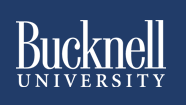
Plagiarism Detection: Viewing "Originality Reports"
This help sheet assumes that you have created a "Safe Assignment" following
these instructions
(page opens in new tab or window). Except for the busiest times of the semester (for example, at the end of the term), the SafeAssign server will produce an "originality report" for each submitted essay within 15 to 30 minutes after the student submits his/her essay to your course. You can easily find those "originality reports" within your Blackboard course, as follows:
- Access your Blackboard course by logging in to
myBucknell (opens in new window) and by clicking on the relevant course listing in the My Blackboard "gadget" on that page or by logging in directly to
Blackboard
(opens in new window).
- If you are on the main My Blackboard page in Blackboard, you can access your course by finding it in the Custom My Courses module in the middle column on that page and then clicking on the link for the course:

- To edit your course in Blackboard, you need to make sure that the Edit Mode switch at the top-right corner of the page is in the On position, which it should be by default:

If the Edit Mode is in the off position, you need to click on that switch to turn editing mode back on.
- Within the Bb 9 Control Panel on the bottom-left of your screen, click on the Course Tools link to expand that section, and then click on the SafeAssign link in the alphabetical list of tools in that section:
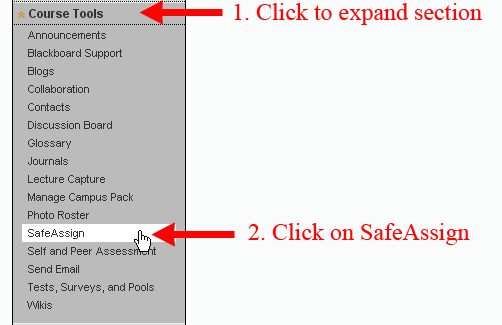
- On the SafeAssign page, click on the link for SafeAssignments to view the list of SafeAssignments in your course:
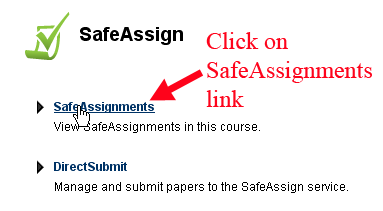
- On the SafeAssignments page, you will see a list containing the name and instructions for all of the "Safe Assignments" in your course. Click on the "chevron" (or double down-arrow) next to the name of the particular assigment whose reports you will be checking, and click on "View Submissions" on the menu that drops down:
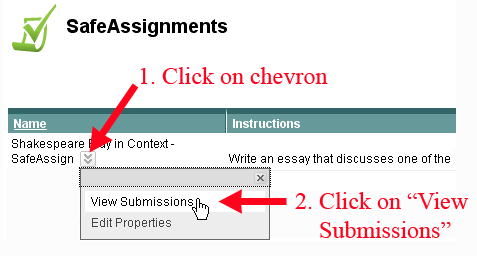
- You will be taken to a View Safe Assignment page, with a spreadsheet-like summary of all the assignments submitted to you. Blackboard will list all the assignment submissions (with a link to each file), when the assignments were submitted, and what the "Matching" score is - in other words, what percent of the assignment appears to match other documents in the local and global SafeAssign databases:
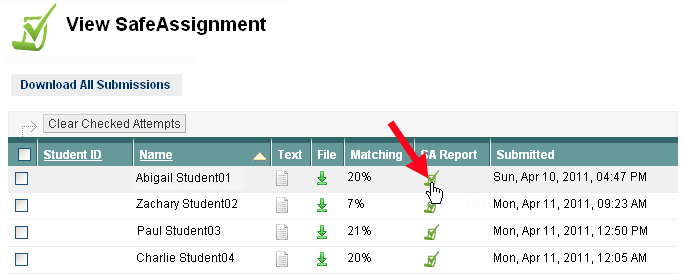
The "Matching" score can be very misleading, because quotations within a paper are counted as part of that score, since the text of a quotation matches its source word-for-word (when done correctly). SafeAssign isn't smart enough to identity quotations and remove them from the score. In other words, you can't really expect a 0% matching score; what you hope for is a low score, indicating that most of the language in the submitted assignment appears to be original. We emphasize "appears to be" in the previous sentence, because SafeAssign reports are only as good as the database to which each assignment is being compared. A student can take an entire essay from an online journal not part of SafeAssign's database, submit the article to you, and receive a low match score. Similarly, a student could copy a passage word-for-word from a printed book. If that particular passage from the book hasn't been quoted by other students at Bucknell or elsewhere, SafeAssign won't catch the copying. SafeAssign provides mostly a deterrence against cheating, rather than a guarantee that a cheater will be caught. Faculty members still need to rely on their judgment when determining if the language used in an assignment sounds too sophisticated for the student who submitted the essay, or too familiar to something in the published literature about a topic. Similarly, a student cannot use a low SafeAssign matching score as "proof" that s/he didn't plagiarize the essay. That low score is just "proof" that the assignment didn't match materials that are part of SafeAssign's database. (For this reason, we recommend that you not allow students to see those matching scores.)
To view a SafeAssign report for a particular student, click on the  check mark in that student's row, as indicated by the arrow in the figure above. check mark in that student's row, as indicated by the arrow in the figure above.
- SafeAssign will open a new window and tell you that it is generating the report. The most crucial sections of the report are the "Suspected Sources" and "Paper Text" areas. The "Suspected Sources" section indicates the online and other sources in SafeAssign's databases that matched with text in the submitted assignment. Those sources are numbered, to make it easy to find the passages in the student assignment (in the "Paper Text" section) that match the source. To make it easier to find the matches, click on the "Highlight All" button, which will color-code all the matches:
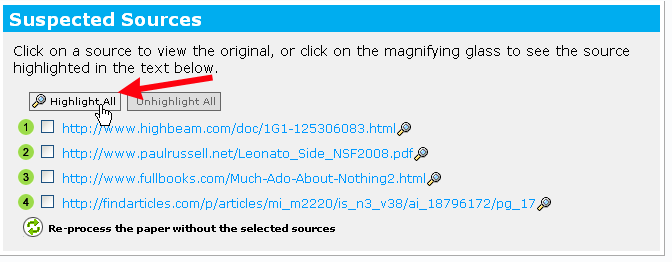 |
| Figure 1. Suspected Sources, Without Highlights |
| |
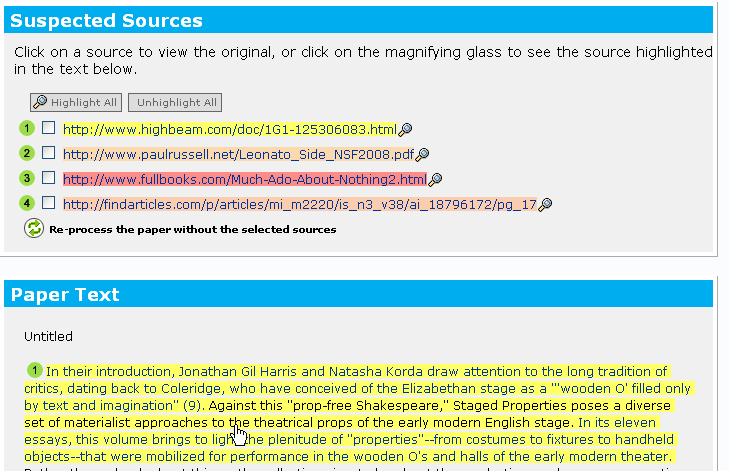 |
| Figure 2. Suspected Sources, With Highlights |
-
As you can see in Figure 2 above, the highlighted matches are color-coded to make them easier to see, with all the passages from the same source marked with the same color. You can click on one of the highlighted passages (in the "Paper Text" area) to see a side-by-side comparison of the text in the student assignment and the "matching" text from the online source:
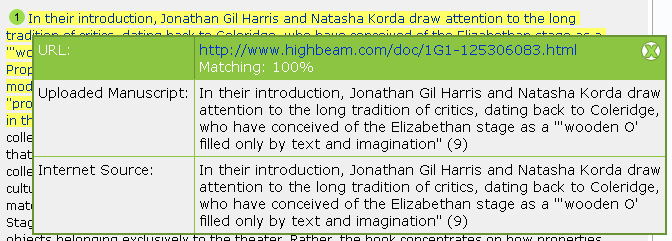
You can click on the "X" in the top-right corner of the side-by-side comparison to close it out, and you can click on the other highlighted passages to view the comparison between the student's essay and the source that it matched.
- When you have finished viewing the report, you can click on the Close link in the top-right corner of the page to close out the window:

- You will return to the View Safe Assignment page. You'll want to stay on this page, in order to follow the next set of directions: Downloading Completed Assignments.
Last revised
April 20, 2011. Please send questions or comments to itec@bucknell.edu.
|
